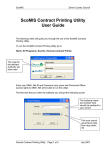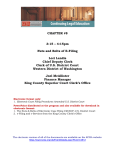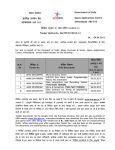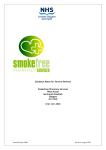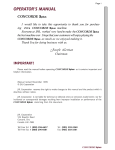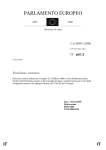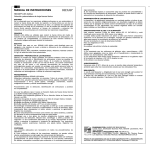Download Requirement Assessment Team feedback User Guide We recognise
Transcript
Requirement 1 Assessment Team feedback a) Engage regularly with a wider range of less expert users of these statistics outside of the Scottish Government’s key stakeholders b) Ensure that both expert and nonexpert users are consulted about changes to the statistics through an early and comprehensive consultation c) Publish the results of the user consultation 2 Publish more detailed information about the uses, users, and users’ views of the police recorded crime statistics User Guide We recognise that you have included a section in the Guide specifically related to users and uses. We would encourage you to make this section more prominent, by introducing it earlier (as it is currently section 19 of 21); given the purpose of the document. We have some more specific observations: • • • • More specific information should be included on who the actual users are and what they are using the data for, what decisions do the statistics inform, and what are the potential uses of the data. You have included a lot of information about the Scottish Government’s uses of the statistics, but by contrast, there is limited information on uses outside SG. Could feedback from your recent user event inform this? Who are the ‘Justice Board’ – it is referenced in section 19, but it is not clear who they are? Section 20 of the Guide presents the results of some consultations; it is unclear if these also include the actions that SG planned to undertake in response to the user feedback. You could include a reference to the Scottish Government’s recent User Event and a summary of the discussions, reasons for holding the event etc; as well as a link to published information about the event. Bulletin The extract of the bulletin we received didn’t contain any information on users and uses. Will this be included in the final version of the bulletin? With reference to Annex 1, para A1.8 of Assessment Report, we would expect to see improved information about specific uses, rather than broad descriptions of use within Scottish Government. Do you plan to address this in the User Guide? 3 a) Develop a statistical work plan annually b) Consult users on the priorities set out in the plan c) Publish the Justice Analytical Services Division; Analytical Programme as soon as it has been approved by the relevant Minister in the future 4 a) Inform users about the ongoing work with Police Scotland and the SPA to develop a consistent publication plan b) Consult more widely about users’ need for more frequent statistics User Guide The Guide could be used to address part of this Requirement, but you may be intending to do this with another of your planned documents. We have provided feedback in relation to the type of information that you could include, to enhance transparency about the different organisations (this feedback also relates to c) Publish the results Requirement 7): • • 5 Confirm that future changes to methods or classifications will be announced in advance of the publication of Recorded Crime in Scotland (para 3.7). 6 Provide more information to users about the nature and extent of changes made to police crime records (para 3.9). It is unclear whether the ongoing work with Police Scotland and the SPA was presented/discussed at the recent User Event. Section 4.1 of the Guide could be expanded to include more information about when Police Scotland publishes its own MI, when they submit this data to the SPA; and the relationship between the Police Scotland MI and the SG statistics. In some cases Police Scotland, SPA and SG will be essentially publishing information from the same source but at different times and in different formats, with different levels of quality assurance carried out on it. The User Guide does not include information about this, to provide guidance to users on which source is most appropriate for their intended use. Bulletin Does SG plan to meet this requirement in full by information presented in the User Guide? Technical Report The Technical Report includes reference to some changes that will be made to Recorded Crime in Scotland in terms of revisions that will be made, but it does not make reference to any changes in classifications for the year 2013-14 or future years. Since it is due to be published at the same time as, or after, the 2013-14 bulletin, it therefore does not give users advance warning of future changes to the data. User Guide The Guide presents helpful information about the extent and nature of changes made to police recorded crime data, and the reasons why Scottish Government has been unable to quantify the extent of changes in the past. It is helpful for users to know that you will be reconsidering this in light of the new IT systems that are being implemented in Police Scotland. Bulletin Will there be more detailed information on the impact of changes in crime classifications, and the nature and extent of revisions, in the final version of the bulletin, or will it link to the relevant section within the User Guide/Technical Report? Technical Report The tables showing the magnitude of the revisions being made due to the introduction of ScOMIS are useful, although this information could be made clearer. The text in the report can be repetitive, which can make it more difficult for the user to get a clear understanding of what the main issues are. There is also no revisions policy for these statistics. The report explains what revisions were made for this year, but not what the policy for revisions will be in future years. 7 Publish information about the roles User Guide and responsibilities of the We can see that Section 3 includes broad descriptions about the organisations involved in the roles of Police Scotland, the SPA, HMICS etc, but the production and publication of police descriptions are quite brief in places. For example: recorded crime statistics (para 3.10). • You could say more about their roles in the production of SG’s statistics - for example, how Police Scotland aggregate the data, how often do they submit data to • • • SG, how do they QA their own data, how is their ‘analysis’ team structured etc. Some of these questions may be answered by the Technical Report or ‘Framework of assurance’ documentation, but if they don't, they should, and elements of this could be reflected here. The information about the roles of the Crime Registrars is very brief – again, you may plan to cover this in other pieces of documentation, but it feels appropriate to include further information here. We would expect this to include information about how the Crime Registrars are scrutinised, and by whom. It was fairly unclear in the Guide how these organisations are linked to each other, and what their remits are. Perhaps a diagram (with supporting text) would help to serve this purpose? As an overall comment, there seemed to be some duplication across sections 3 and 4 of the Guide, so you could consider combining the sections and removing duplication, and improve the cross referencing to other related sections of the Guide, as well as to links of relevant published information. Bulletin Does SG plan to meet this requirement in full by information presented in the User Guide? How does SG plan to address this – in separate documentation or within the Bulletin? 8 Document and publish how those who produce the statistics are protected from any pressures that might influence the methods, content or timing of the police recorded crime statistics (para 3.13). 9 a) Publish the proposed Technical User Guide Report as soon as it is finalised, We were unsure whether you intended that the Guide addressed ensuring that the language and Requirement 9. For part b) of this Requirement, you have content of this report is accessible to included some detail about the methods used to produce the non-expert users b) Publish detailed information about statistics. But these seem to be described under different sections, so the information is not as coherent as it could be, in a the methods used to compile the statistics alongside each release of way that helps users’ understanding of how the statistics are compiled. You may be planning to meet this Requirement in its Recorded Crime in Scotland (para 3.18). entirety in the Technical Report. But it is worth considering the clarity of how information on methods is presented in the Guide. Bulletin The extract of the bulletin we received didn’t contain any information on methods used to compile the statistics. Will this be included in the final version of the bulletin or linked to from it? The technical report has also highlighted that there are comparability issues with the Offences Groups – the extract of the bulletin that the Assessment team has seen does not include information about offences and trends over time (alongside sufficient caveats about comparability and reference to relevant sections of the Technical Report). Does SG plan to include recorded offences in the bulletin alongside police recorded crime? We consider that including statistics about offences forms an important part of the picture? Technical Report The report could be reviewed for repetition, for example the Executive Summary is has very similar content as section 1. There are several questions that arose when reading the Technical Report, that aren’t fully addressed by its content: • This Requirement includes publishing information about the methods used to compile the statistics, but this Technical Report focuses primarily on the methods used in the data reconciliation exercise that SG undertook. Where does SG plan to include detail about methods used to compile the statistics? Where will it include information about revisions and corrections? • Accessibility: The references to ‘Group 5/6’ should be expanded (to include the name/description of the offence group), so users are clear about what the comparability issues relate to. • The document states that “Scottish Government are satisfied that crime data, Groups1 to 5 are comparable pre and post reform.” But there does not seem to be a great weight of evidence presented in this report to support this. There is a lack of detailed information about how the analysis comparing the ScOMIS data to the Scottish Government legacy data was carried out. For example, what where the tolerances applied for each crime group? How did you determine the tolerance ranges (were they arbitrary)? What are the results of the reconciliation that ‘passed’ the tolerance check? There does not seem to be a clear indication of this in the report. • The information in the Annexes on the scale of differences that ‘breached’ the tolerances is helpful and provides the user with a sense of the scale of the issues that arose from the work. • The description that the Scottish Government provides on the reasons for differences in recorded crimes between the two data sources is helpful, particularly in relation to the re-classification of a crime and ‘nocriming’. There is no indication of the potential scale of either of these reasons being the reason for differences – is it because you cannot determine this from the reconciliation? This should be made explicit to users. 10 a) Publish the analysis comparing the police recorded crime statistics and the Scottish Crime and Justice Survey, and any other relevant sets of statistics b) Include a clear explanation about how this analysis could assess the scale of any difference between crimes recorded by the police and that experienced by the population resident in households, and the resulting impact on how users should interpret crime statistics (para 3.20). 11 Bring the analysis and commentary of the two main sources of crime statistics together into a single published report and present a coherent summary of crime based on both data sources (para 3.21). Further evidence called ‘SCJS chapter’ has since been submitted by the Scottish Government. This has not yet been reviewed and therefore the feedback below focuses only on the extract of the bulletin sent to the Assessment team. Bulletin The 'information box' on SCJS compared to Police Recorded Crime is helpful, but we think the content could be refined to make it more understandable for users. The 'information boxes' could simply say what the user should consider when interpreting the analysis of police recorded crime. So, for example, the section on 'total recorded crime' says crime is going down and has fallen by X% since YYYY - the box could explain what crimes are comparable with the SCJS and whether, for the comparable crimes, the trends over time for SCJS are consistent with the police recorded crime, and if not, why not. Threading references to the SCJS throughout the PRC publication would ensure that users are aware of when it might be better to use the SCJS than PRC, or when the results from the two sources differ, and why. 12 Publish information for users, alongside the police recorded crime statistics, about how it assures itself of their quality, including its assessment of any risk and potential source of error associated with the use of the underlying administrative data source (para 3.23). User Guide You have included information primarily in Section 9 of the Guide to help address this Requirement. Overall, the related information in the Guide is a little confusing as different elements of quality are addressed throughout the document, they could be brought together into section 9 or more clearly signposted from it. In addition, the level of detail about the assurance mechanism is quite broad, and not supported by evidence in the way the text is currently presented. The ‘Framework of Assurance’ document should provide further detail, but this could also be reflected in the Guide. Specific examples of the lack of detail includes: • • • • • Scottish Government checks “data across legacy police force areas to ensure consistency and confirming local differences; and comparing figures year on year, investigating where substantial differences appear.” It would be useful to describe what SG consider as substantial? “Once the Police are happy that the final resulting data are an accurate reflection of police activity within each financial year period, then the data is signed off and considered ready for publication”. What is meant by this? How do they ‘sign off’ the data? “In addition to the rigorous quality assurance work that is already undertaken, JAS can now quality assure the individual quarters.” It would be helpful to explain what you mean by ‘rigorous’, the Guide doesn’t contain information about the detail of the QA process “A wide range of mechanisms are employed to ensure the robustness of police recorded crime data” – will these mechanisms be described in the ‘Framework of Assurance’ document or Technical Report? For example, does Scottish Government use the various audits, along with their own QA, to make a decision on whether the data is fit for purpose? What would happen if they didn’t feel they had sufficient confidence in the data? How are SG reassured that ‘no criming’ is carried out • • • consistently throughout Scotland and is not being used to reduce the number of crimes in certain areas? Again, you may plan to cover this in other documentation. The Guide will need to include reference to the forthcoming HMICS results once available. This section does not include a reference to the ‘Framework of Assurance’ document yet, but we recognise that this is a draft. There doesn’t appear to be a reference to potential sources of bias and error. Bulletin Will the final version of the bulletin include information on the quality of the data or will it have a link to the relevant section of the User Guide? Technical Report The Technical Report provided some reassurance that the errors found in the legacy systems with regards to inconsistencies in IT systems and policing practices should not be transferred through to the ScOMIS system, but little information on what processes are in place to prevent these types of inconsistencies from arising in the future. For example will ScOMIS remain once i6 is introduced or are there other imminent IT changes that could impact on the statistics in the short or medium term? 13 a) Keep users informed about the User Guide progress of the HMICS audit We feel that we cannot provide an informed judgement of the b) Publish demonstrable evidence evidence in the User Guide at this point, as it does not yet that the findings from the include much information about the recent HMICS audit, We forthcoming HMICS audit have been integrated into the compilation of the would need to see an updated version of the User Guide, along with the ‘Framework of Assurance’, the Technical Report and a statistics presented in Recorded draft of the forthcoming statistical report. Crime in Scotland c) Update published quality information for police recorded crime Bulletin statistics in the light of the findings of The extract of the bulletin we received didn’t contain information the forthcoming HMICS audit, about the recent HMICS audit. Will this (or links to this making it clear how the outputs from information) be included in the final version of the bulletin? the audit inform the Scottish Government’s understanding of the quality of the statistics d) Consider whether statistics based on police recorded crime data can be produced to a level of quality that meets users’ needs 14 More clearly document the User Guide relationship between different We consider that section 17 contains helpful information about sources of crime statistics across the the range of related statistics across the criminal justice system criminal justice system in Scotland which helps to provide a better context for users who are (para 3.27). interested in this topic; you could also consider adding information about the coherence between Scottish Government’s statistics and the Police Scotland MI or the SPA Performance data – this may be information that is more appropriate in another section of the Guide. Bulletin The extract of the bulletin we received contained reference to the Homicide in Scotland statistical bulletin, including an explanation on how the statistics differ from those in the Recorded Crime in Scotland bulletin, advice on when to use the bulletin, a link to it, and information on when the next bulletin is due to be published. Will this level of information (or a summary and links) be included in the Recorded Crime in Scotland bulletin for the other crime-related statistical bulletins? 15 Provide information to users about User Guide the comparability of the police Section 18 presents helpful information to users about related recorded crime statistics with those statistics across the UK. We felt that a bit more information could published in the other be provided to explain the nature of differences between the administrations of the UK (para Scottish Crime Recording Standards and the National Crime 3.28). Recording Standards, and the potential impact of the differences on police recorded crimes? Bulletin The extract of the bulletin we received didn’t contain information on comparability across the rest of the UK. Will this be included in the final version of the bulletin? Or will a link be added to the relevant section of the User Guide? 16 Review the staffing profile of the Justice Analytical Services statistics team and provide the Authority with an assurance that the production of police recorded crime statistics is adequately resourced (para 3.31). 17 Improve the commentary for police recorded crime statistics by: a) Clarifying the strengths and limitations of the statistics b) Provide further explanatory information about the context User Guide We recognise that the Guide includes some explanation of the impact of changes to crime and offences classifications on the data and how the data should be interpreted, particularly the history of changes in Section 11. In order to make a fuller judgement about whether this Requirement has been met, we As part of meeting this requirement would need to see a draft of the next publication of Recorded Crime in Scotland. the Scottish Government should consider the points detailed in annex 1 and annex 2 (para 3.33). Bulletin The extract of the bulletin received by the Assessment team does not provide sufficient evidence to meet the Requirement. It would be useful to ensure that Annex 1 of the Assessment Report is considered when the commentary is drafted. We note that the bulletin has moved to presenting statistics by Local Authority instead of legacy police force and the section we have seen includes some further detail about the statistics, and charts to illustrate the statistics for users. Some charts need titles reviewed when you are doing another proofread. Further comments on the extract are below: Overall trends in recorded crime – there is scope to include more commentary to help users understand possible reasons for the trends in recorded crime since 1971. Chart 1 presents ‘key changes’ that could affect the numbers of crimes recorded over time, but this could be supplemented by further context in the supporting commentary. In addition, the trends in recorded crimes should be supplemented by the trends in the number of offences recorded over time, to provide context to users in understanding how the numbers of recorded offences is related i.e. could a decrease in recorded crimes be partly explained by an increase in offences reported; has a change to the SCRS affected this? Without this information, there is a risk that the statistics will present only part of the picture. Local authority analysis – The charts are helpful to present some of the differences across Local Authorities. Could more context be added? For example, are any of the changes over time linked to specific policing priorities, e.g. are police in Shetland targeting vandalism? And more analysis on longer term trends would be useful. Are any of these increases or decreases sudden changes or are they all gradual changes over the last few years? There is scope for more context to be included to explain the largest increases and decreases, for example the 30% fall in recorded crime in Eilean Siar; the 14% increase in Edinburgh city. The current presentation of brief contextual information in the ‘commentary’ section seems a little disjointed, and doesn’t really provide sufficient explanation of possible reasons for specific trends, particularly at a local authority or crime group level. Crime rates per 10,000 population - More context needed. It is unclear whether the current crime rate is in line with the longer term trend. Any comparable data in other countries? Or could compare with previous years? What is the longer term trend? Clear-up rates – This section doesn’t seem to be appropriately introduced, this may because you have sent us an extract, or because you have not drafted these aspects. Again, the commentary needs to include more context, comparable statistics, longer term trends. For example, what is included in ‘other crimes’ that makes its clear-up rate so high? Why the sudden increase in ‘sexual crimes’ and the increase since 200607 in ‘non-sexual crimes of violence’? Has there been a specific drive by Police Scotland to target ‘detections’ for specific crime groups, for example. Could you include possible reasons why clear-up rates differ between Inverclyde (70%) and those LA’s that have 100% clear-up rates. Perhaps the HMICS report may be able to provide helpful context in these cases. The commentary should also include an explanation of what clear-up rates are and how they are calculated. The commentary makes reference to the ‘Group 1/2/3’ sections, but this could be expanded on, as a more casual user may not be immediately clear that you are referring to a section on ‘nonsexual crimes of violence’, for example. Group 1 non-sexual crimes of violence - similar issues here, the section needs more context beyond the current presentation of increases and decreases. Although there is some mention of changes over the last 10 years and of different police operations that have been implemented, there is no coherent explanation that links this information together and gives a clear picture about what has happened in terms of non-sexual crimes of violence over the last 10 years. The reference to SG’s other publication, Homicide in Scotland, is very helpful, so users are informed that they can access further analysis of this Crime type. It would be helpful if the commentary could give an indication of the scale of the difference in the recorded crime data presented in each publication, as a user may be unclear about whether the differences are substantial. Will analysis of offences be included in the final version of the bulletin, along with an explanation of the discontinuities discovered when Police Scotland was introduced? 18 a) Investigate users’ need for more detailed record level data to enhance analysis b) publish the results of this investigation, including how it plans to take the outcome forward when the legacy systems are replaced with the i6 national data collection IT system (para 3.35). 19 Review and update where necessary, the formats in which it publishes police recorded crime statistics in order to meet the needs of users (para 3.36). 20 Ensure that pre-release access for Does the list include those who the draft was circulated to? Recorded Crime in Scotland is only granted where absolutely necessary (para 3.40). 21 Update its Statement of Administrative Sources for police statistics to include full information about the arrangements for auditing the quality of the administrative data used to compile Recorded Crime in Scotland, taking into consideration the recent Authority Statement Administrative Data and Official Statistics, and associated documents, and the National Statistician’s Interim Guidance (para 3.41).











